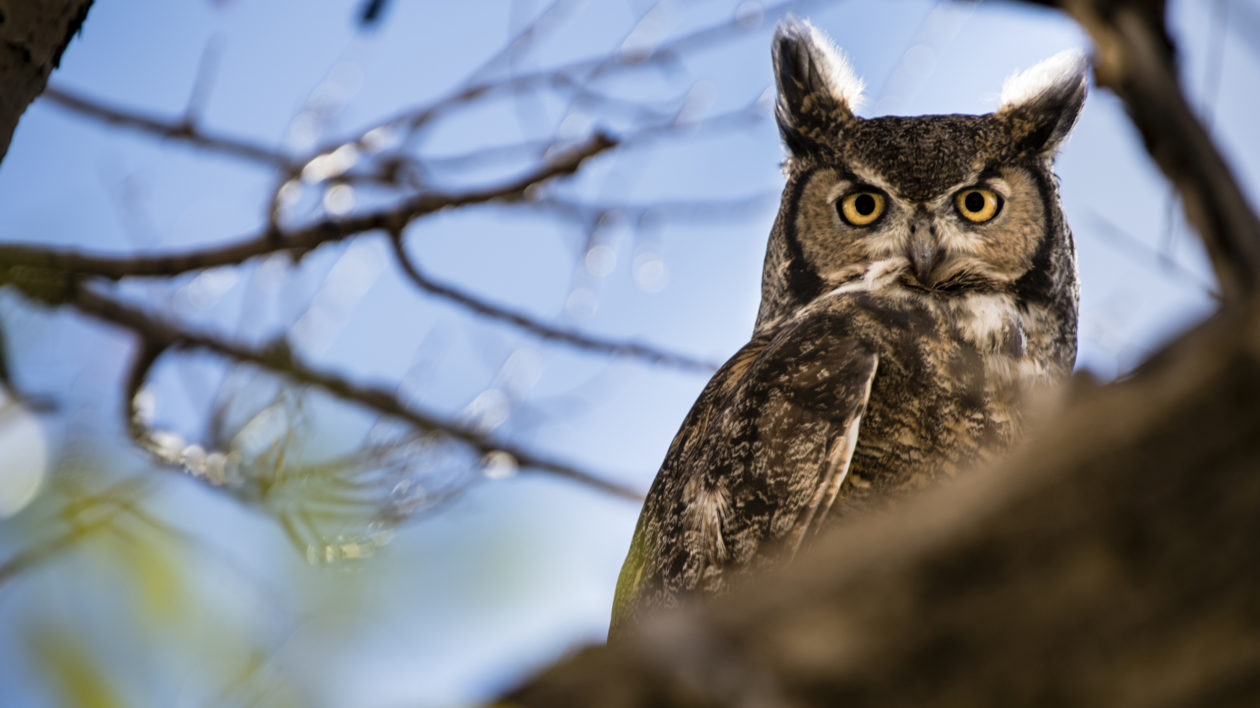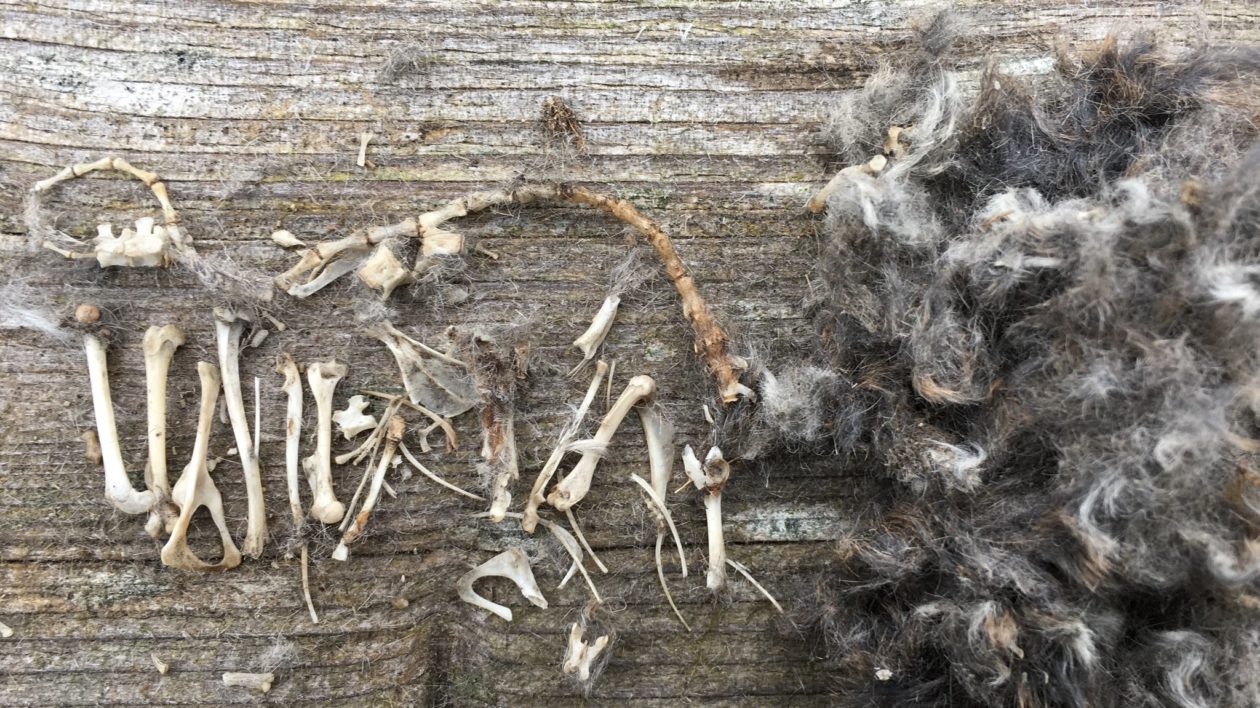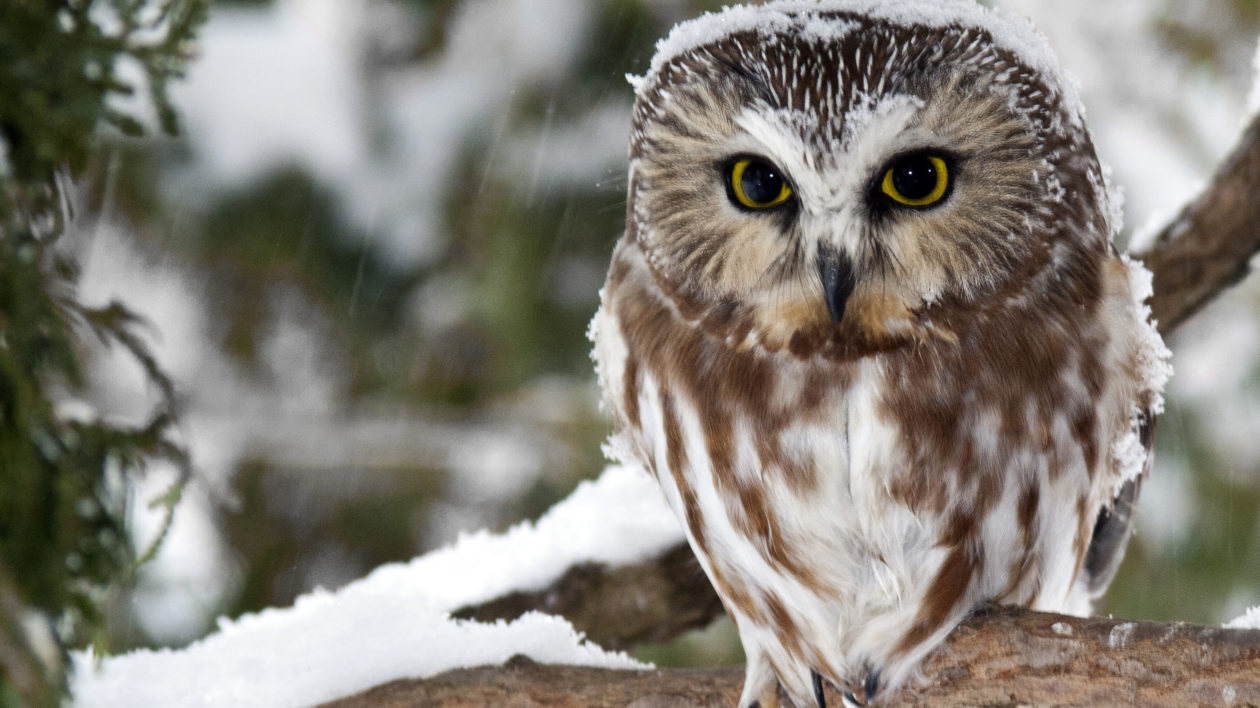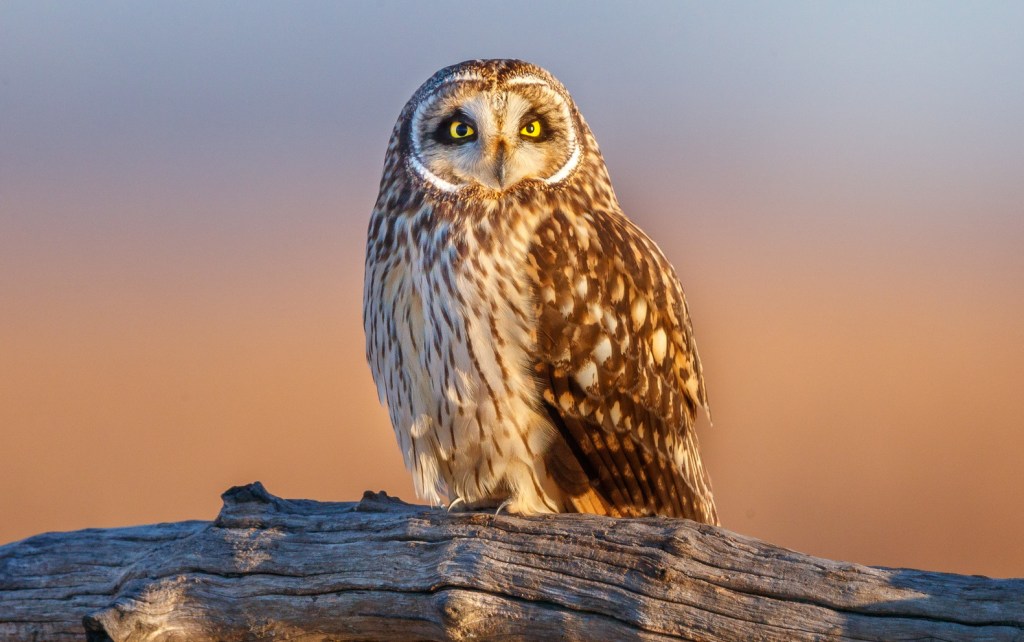Last evening, my young son and his friends sprawled out on a backyard trampoline, staring at a great horned owl on a branch directly overhead.
They giggled as the owl hooted, squawked, preened and swiveled its head around. The owl seemed curious about the children, periodically staring straight down at them. More laughter.
Great horned owls are one of the most charismatic creatures to watch. They are both vocal and visible. Even better, they’re one of the most adaptable large birds in North America. There’s a good chance that a great horned owl lives in your neighborhood or at a nearby city park, woodlot or farm.
Now is the best time of year to go owling. You don’t need to be a life-listing birder or skilled field naturalist to enjoy spotting and listening to owls. It’s the perfect outdoor activity for the whole family. And if you are a serious bird nerd, the winter offers more rare owl opportunities, too.
Here’s a guide to enjoying owls this time of year.

Great Horned Owls: Enjoying the Hooting Season
At this time of year, in the right location, a chorus of hoots provides the soundtrack to dawn and dusk.
That’s because, around October, male great horned owls begin setting up territories. Most great horned owls mate for life, but in the fall the pair begin a courtship display, loudly calling to each other.
The great horned owl’s hoot is pretty much unmistakable, although ornithology web sites often describe it in different ways. A common hooting pattern is a longer hoooooot, followed by two or three shorter hoots.
And these owls have a range of other vocalizations, too, some of which sound like barks or a screeching cat. (Cornell’s All About Birds site features some great audio of these different calls).
The owls continue setting up their territory this month, and begin setting up a nest.
They’ll use an abandoned nest previously used by a red-tailed hawk, squirrel or other critter. Come January, they’ll begin setting in the nest – far earlier than most other birds.
An evening walk is a great way to enjoy the spectacle. You can often get an owl to answer your own hoots. Once you hear one, scan thick tree branches and other potential perches. The great horned owl’s outline is unmistakable. You can often sneak closer and enjoy the owl’s antics up close.
Read more about the great horned owl hooting season.

Collect Owl Pellets
Here’s a fun project if you want to learn more about the owls in your neighborhood.
Owls swallow their prey whole. They cannot digest fur, bone or feathers of prey. These are compacted in the owls’ bowel into a pellet that the bird then regurgitates. If you’re watching an owl and it looks like the owl is gagging or coughing, it is probably expelling a pellet.
These tightly compacted pellets can be found under roost areas used by owls. Owls are creatures of habit so often use the same trees and perches. If you locate a hooting pair of great horned owls on your evening walk, you can likely find their pellets.
These pellets can be dissected to see what the owls are eating. You should heat sterilize the pellet in an oven before working on them, and always handle unsterilized pellets with rubber gloves. You can often reassemble an entire mouse or vole skeleton from an owl pellet. It’s another way to get kids interested in the local birds.

Snowy Owl Invasion
As you take your evening walks, you may well see other species of owls. There are 18 other species in North America, and once you train your eyes to look, you’ll be surprised at the cool species that are out there. Sites like Owling.com can help you identify and spot the full diversity of these fascinating creatures.
In the winter, some of the best owling is not even at night. Take the snowy owl. Usually, this is a species of the Arctic. But some years, snowy owls can be found in many parts of North America, from farm fields to airport runways. These irruptions, as they’re known, are tied to lemming abundance in the north country.
Local birding groups or the iNaturalist app can help you find a snowy owl near you. A snowy owl will often stay in the same general area for weeks or longer.
You can record your sightings for a citizen science effort called Project Snowstorm that tracks annual movements of snowy owls.
Seeing a snowy owl is a highlight for even the most-experienced birders. And the winter owl rarities don’t stop there…

Northern Owls Head South
Three northern owl species – the great gray owl, boreal owl and northern hawk owl – irregularly appear in more southerly habitats during the winter.
As ornithologist Joe Smith writes, these species “all appear in large numbers at southern latitudes when there are fewer rodents in their typical, far-northern winter range. A study in Quebec demonstrated that irruptions of all of these owl species occurred every four years when rodent population cycles bottomed out. In this case, the irruptions represent a change in the movements of owls rather than a change in their population.”
I admit that I love observing birds but all-day bird counts and frenetic listing field trips have always held limited interest. However, heading out to spot a beautiful, rare bird is the kind of quest I live for.
In recent years, local birding groups have reported both northern hawk owl and great gray owl near our southern Idaho home, both highly unusual sightings. The northern hawk owl inspired our first family road trip with my son (he was then 2 months old). We found the hawk owl on a side street in Hailey, Idaho, and even witnessed it successfully hunting a vole.
The great gray owl was located in a city park in Boise, and we were able to observe it from about 20 feet away.
These winter outings bring wild adventure to vacant lots and little parks. They’re treasure hunts, with owls.

Owling Ethics
Owls are often highly visible at this time of year. Great horned owls are adaptable to people and thrive in our neighborhoods. The northern owl species often live in wilderness areas and are much less used to the pressures of humanity. Please give them space.
Some nature photography operators have begun tours, particularly in Minnesota, that feature winter owls as the main attraction. Unfortunately, some of these tours bait the owls with live mice.
My friend and skilled wildlife photographer Mike Furtman has actively campaigned against this practice. He points out that pet-shop mice can contain salmonella. Perhaps even worse, baiting acclimates these owls to people, which poses many dangers. The tours often occur near roads, increasing the chances of the owls being killed by passing cars. Please do not support tour companies that bait owls.
And, as with any wildlife photography, please give the owls plenty of space. I saw people getting right up to the great gray owl I spotted last winter, visibly stressing the animal. Your photo is not worth the owl’s life.
Also, many owls roost on private property. Please respect local neighbors and property owners. Their habitat is getting the owl through the winter so please respect their privacy and property rights.
These simple behaviors will help the owls and still allow you to enjoy one of the greatest shows of winter. Grab a pair of binoculars – or just your curiosity – and take a walk. The owls are out there, if you stop, look and listen.




Thank you for guiding us to being responsible nature watchers!
I live in Florida and need help identifying what may be a Owl Hawk
Would like to email you a photo and video
Please. I want to find a Great owl.
WONDERFUL!!!…..Thank YOU!…..HUGELY!!!!!….I agree with Mr.Furman……NO OWL BAITING,PLEASE!!!!!
Sincerely,
BillyD
Beautiful photos! thank you!
Great article, I usually prefer ebird to inaturalist to find bird observations because there are more bird reports on there.
I have enjoyed the fun.
Wonderful information. I have heard owls hooting to each other in my neighborhood in Austin, Texas. We live near the Balcones Canyonland Preserve, so I suspect owls have found this area quite suitable. I have never actually seen any owls, but with the information provided in this article, I will know what to look for. I am not sure which owls are typical for this area , but I intend to find out. I would like to get an owl house for the numerous trees on our property. There is not a lot of traffic or activity in my neighborhood, so I think an owl house might work.
Im a owl fan and usually when I go camping. I use my caller and play owl calls to get an owl to respond which I do have success. I had a Great Horned owl respond to my call on my cell phone. It kept it up about 45 minutes. Wayne Johnston
I want to send a picture of a snowy owl in flight where do I send it?
For the past two nights I have heard an owl outside my bedroom window. He/she was very loud. One long hoot, two short, pretty much every 27 seconds. It was wonderful. I felt sorry for the birds this week as it is finally winter in New Jersey and the temperatures have dropped greatly so I spread a twenty pound bag of bird seed around the base of my bird feeders and in a fifteen foot line. If I only fill the feeders I have found that the blue jays and the squirrels bully the other birds. Perhaps the owl has come for a nocturnal mouse or two that are also feeding on the seed I spread. Or maybe, as you informed me, the owl is just claiming its territory. What ever the reason I hope it likes it outside my bedroom window and visits me again. Thanks for the article.